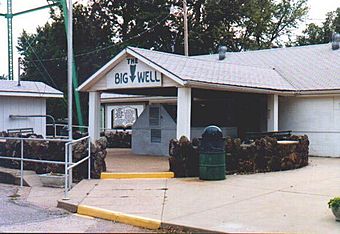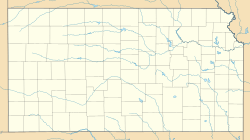Big Well (Kansas) facts for kids
Quick facts for kids |
|
|
Greensburg Well
|
|

Former Big Well visitor center before it was destroyed by a tornado in 2007
|
|
| Location | 315 South Sycamore, Greensburg, Kansas |
|---|---|
| Area | 1 acre (0.40 ha) |
| Built | 1887 |
| Architect | Wheeler, J.W. |
| NRHP reference No. | 72000507 |
| Added to NRHP | February 23, 1972 |
The Big Well is a very large, historic water well located in Greensburg, Kansas, United States. It's so big that visitors can actually go inside it! You pay a small fee, then walk down a lighted staircase to reach the bottom of this amazing well.
History of the Big Well
Work on the Big Well started in 1887. It cost about $45,000 to build, which was a lot of money back then! Its main purpose was to provide water for the Santa Fe and Rock Island railroads. The well was finished in 1888.
It served as the main water supply for the town of Greensburg until 1932. Because of its importance and unique size, the Big Well was named a National Museum in 1972. The next year, in 1973, it received an American Water Landmark award from the American Water Works Association. It has also been listed on the National Register of Historic Places (NRHP) since 1972 under the name "Greensburg Well." In 2008, the Big Well was even named one of the "8 Wonders of Kansas"!
How the Big Well Was Built
Building the Big Well in 1887 was a huge project that used many clever engineering ideas from that time. Teams of 12 to 15 men worked on it. They used simple tools like pickaxes, shovels, ropes, pulleys, and barrels.
The sides of the well were lined with stones. These stones were brought from the Medicine River, which was about twelve miles south of Greensburg. Wagons were used to carry the stones. Special wagons with slats were used to haul away the dirt they dug out. When a low spot was reached, the slats could be opened to spread the dirt and create level ground around the area.
As the well got deeper, a wide shaft was built. It was supported every twelve feet with strong wooden planks (two by twelve inches) to keep the workers safe. Using these supports, dirt was lifted up in barrels to continue the digging. After the stones were put in place around the supports, the wooden braces were carefully sawed off. When the well reached about 109 feet deep, special pipes with holes were pushed sideways into the gravel. This helped water flow into the well's basin.
The Big Well Museum
The Big Well used to have a visitor center that told the story of its construction. However, on May 4, 2007, a powerful tornado hit Greensburg and destroyed the center. The good news is that the Big Well reopened on May 26, 2012, with a brand new museum!
The new visitor center, now called the Big Well Museum, has a cool circular timeline. It shows the history of Greensburg in three main parts: how the town began, the tornado event, and how Greensburg was rebuilt to be eco-friendly. The museum also teaches you all about tornadoes. It explains how these powerful storms form and the weather conditions that caused the 2007 tornado.
You'll find interactive displays, televisions, cards, and infographics. These show historical events, interviews, and even model survival kits. Around the museum, you can see pieces of storm debris. This includes stop signs, street signs, clocks, and even parts of tornado sirens. You can see the remains of Greensburg's old Federal Signal Thunderbolt siren that was destroyed by the tornado. A new Sentry 10v siren was put in place during the rebuilding.
The museum also displays a large Brenham meteorite. This meteorite is a half-ton (about 1,000 pounds or 450 kg) pallasite meteorite. It was found in the area. For a while, it was thought to be the world's largest single-piece pallasite, but other samples are actually bigger. When the tornado hit, the meteorite was reported missing. Luckily, it was later found underneath a collapsed wall! It was temporarily displayed at the Sternberg Museum of Natural History in Hays, Kansas, while the new museum was being built. Now, it's back home at the reconstructed Big Well Museum.
Gallery
See Also
- Pallasite meteorite, a type of meteorite displayed at the Big Well museum
- Woodingdean Water Well, the world's deepest hand-dug water well






